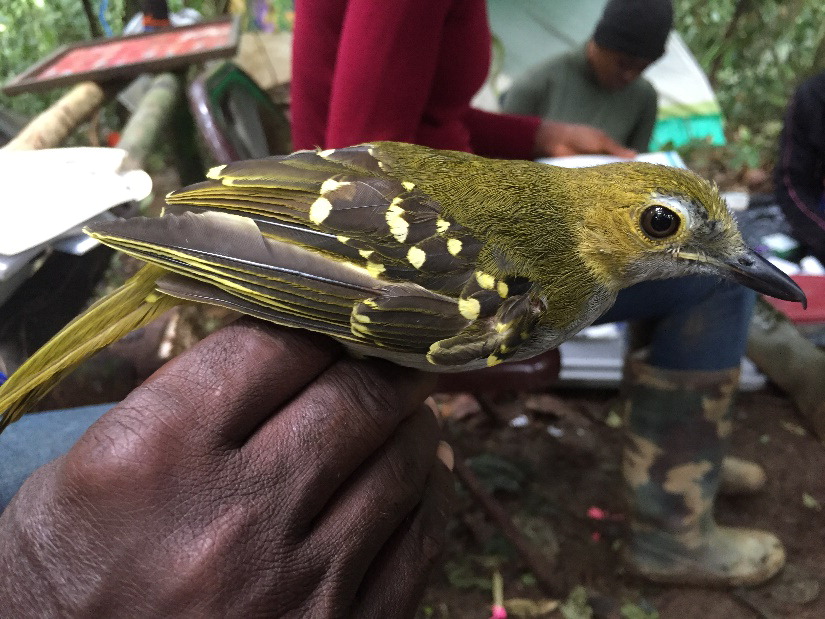|
Cycle 4 (2015 Deadline)
Using geospatial tools to investigate how deforestation affects the transmission of malaria in birds
PI: Anong Damian Nota (damian.anong@ubuea.cm), University of Buea
U.S. Partner: Thomas Smith, University of California, Los Angeles
Project Dates: November 2015 - October 2019
Project Overview
 | | Photo courtesy of Dr. Nota |
This project addresses an unsolved problem in the field of emerging diseases: What are the proximal effects of large-scale deforestation on the transmission of vector-borne infectious diseases? The principal investigator and his team will approach this problem by studying malaria in natural populations of rainforest birds threatened by rapid environmental degradation in Cameroon. It is well established that deforestation poses a major threat to biodiversity in tropical regions; however, its effects on the spread of pathogens are largely uncharacterized. The team has previously identified malaria parasites, both generalists and specialists, in African rainforest birds, and they have found that it is the generalists that have the potential to jump to naïve hosts and develop as emerging diseases. They have also identified mosquito vectors of avian malaria and demonstrated that patterns of malaria diversity are significantly affected by habitat. With their knowledge of sectors presently zoned for logging, they thus have in place an unprecedented model system for investigating the effects of environmental change on disease transmission. They will test the hypotheses that (1) deforestation promotes an increase in ther prevalence of generalist parasites and (2) vector species distributions change with deforestation, and account for differences in prevalence of generalist vs. specialist parasites. The ultimate goal of this research is to discern the interplay among hosts, habitat, and vector ecology on the potential spread of novel pathogen strains. Another important objective is to determine how human-altered environments affect the feeding patterns of insect vectors and what environmental factors are important in determining likelihood of transmission. By applying the same type of relations before and after logging, they researchers should be able to predict where the vectors are likely to occur, where disease is likely to occur, and the patterns may change.
This work will capitalize on the U.S. Government-supported partner’s expertise in molecular biology, parasitology, entomology, and fieldwork and leverages the archive of blood samples that the he and his collaborators have accrued over nearly 30 years from African rainforest birds.
Final Summary of Project Activities
This project, which ended in October 2019, sought to address an unsolved problem in the field of emerging diseases: what are the proximal effects of large-scale deforestation on the transmission of vector-borne infectious diseases. The principal investigator Dr. Nota and his team approached this problem by studying malaria in natural populations of rainforest birds threatened by rapid environmental degradation in Cameroon. They gauged the effects of deforestation on the diversity and host specificity of avian malaria parasites in Talangaye Forest.
Although the civil war in Cameroon prevented them from doing the most crucial part of the work, which was to get samples from the deforested areas for the before and after control-impact pairs (BACIP) experimental design, they were able to capture 2,658 bird species from Talangaye that belonged to 30 families. They subsequently used microscopic and PCR techniques to analyze blood samples collected for the identification of parasites. Out of the 2,658 birds collected, 1,195 were found to be infected with parasites (Plasmodium, Haempoproteus, Leucocytozoon, Micrrofilariae, and Trypanosomes). More than 1,000 sequences of parasites have been done on Plasmodium, and two PhD students are still carrying out blasting to identify avian malaria parasites in Cameroon.
In order to measure the effects of deforestation on mosquito communities, the PI and his team collected 12,272 mosquitoes belonging to 12 mosquito genera. More than 20 new potential species of mosquitoes not previously described have been named, and this number may increase as the students continue to use dichotomous keys and PCR to look at the various species.
The project was meant to have only one PhD student but ended up having 13 students at both the Masters and PhD level. Five have defended their MSc degrees in the project. One of the students has enrolled in a PhD program in the Department of Vector Biology and Parasitology to continue to look at vectors collected in Talangaye. Four other students are currently pursuing their PhDs and should be able to graduate in 2020. The project has increased the capacity of students in this area who will later on join the university as faculty members or move to other conservation projects. In addition, the PI reports that the PEER project had a good impact on science and led to a number of academic awards. During the grant period, three of his students won the “Idea Wild Award” for equipment in the field. These are international awards that were awarded for the PEER work done in Talangaye. Lastly, one PhD student, Mayi Audrey, won the National Geographic Travel grant to visit the United States in 2019 for further training on vector biology with Dr. Anton Cornel, a medical entomologist at the University of California, Los Angeles (UCLA).
U.S. partner Dr. Tom Smith runs a weekly one hour seminar course every quarter as part of his teaching curriculum at UCLA.The course is based on discussion of readings selected from current literature. This opportunity was offered to all the PEER-selected students from the three institutions in Cameroon beginning in the fall of 2015 and continuing to date. This has created opportunities for building relationships between African and U.S. students. This course also provides opportunities for participating faculty and students to build lasting international collaborations.
| 



